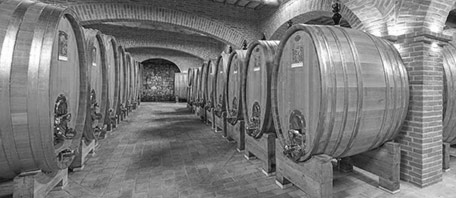
Which site would you like to visit?
By clicking the retail or wholesale site button and/or using rarewineco.com you are choosing to accept our use of cookies to provide you the best possible web experience.
Biondi-Santi’s success in the late 1800s gave Brunello its ring of nobility. And one vintage, the legendary 1891, was the most celebrated Biondi-Santi of all, and the wine that most forcefully argued for the region’ potential.
For the next 100 years, Biondi-Santi stood apart from all Brunello producers, producing a number of Brunellos—and especially the rare Brunello Riservas—that have not only become legendary, they have come to define classic Brunello.
It was Clemente Santi, armed with a science degree from Pisa University, who began experimenting with a particular clone of Sangiovese—known locally as “Brunello” for its brownish hue—on his family’s Tenuta Greppo farm near Montalcino in the mid-19th century.
But it was his grandson, Ferruccio Biondi-Santi, who is credited with first making a pure Brunello wine, without the softening additions of white grapes or governo (concentrated grape must) universally in Tuscan use at that time.
What Clemente and Ferruccio had discovered was that Brunello, grown in Montalcino’s high-altitude very rocky galestro and clay soils and given a lengthy fermentation and maceration with the skins, followed by extended aging in cask, produced a very structured, aromatically complex and long-lived wine.
Biondi-Santi Brunello’s extraordinary capacity for development with age soon gave it a reputation as not only Tuscany’s, but Italy’s greatest red wine, placing it among the world’s most coveted by the beginning of the 20th century.
Tancredi Biondi-Santi succeeded Ferruccio upon the latter’s death in 1917, and was responsible for such legendary Brunellos as the 1955 Riserva. But he also initiated the estate’s practice of topping up and recorking the old Riservas to ensure their integrity, and authored the standards for production used in creating Brunello di Montalcino as a DOC (denominazione di origine controllata), or appellation of controlled origin, under Italian wine law.
Franco Biondi-Santi took over the estate in 1970 and ran it with brilliance for the next 43 years. In fact, it can be argued that his wines got better as he aged, reaching a pinnacle during the last decade before his 2013 death at the age of 91.
His later achievements included the predictably great 2004, 2006, 2007, 2008 and 2010 Brunello Riservas. But Franco also delivered the occasional bombshell, such as the 2007 Brunello Annata (normale), judged by Antonio Galloni to be the virtual equal of the 2007 Riserva—despite the huge gap in price between the two.
The Biondi-Santi traditions continue, unchanged, in the very capable hands of Franco’s son, Jacopo. The Brunello production is divided into two wines, based on vine age and vintage. The Brunello di Montalcino Annata is made from the fruit of vines between 10 and 25-years old, destemmed, fermented for 15 to 18 days in temperature controlled vats and then aged for 36 months in large Slavonian oak botti.
The Riserva is made in the same way, but only in exceptional years from a selection of fruit from vines over 25 to 80 years of age, aged for six years before release. The estate also makes a fine Rosso di Montalcino from its youngest vines, aged for one year in botti.
New discoveries, rare bottles of extraordinary provenance, limited time offers delivered to your inbox weekly. Be the first to know.
Please Wait
Adding to Cart.
...Loading...


By clicking the retail or wholesale site button and/or using rarewineco.com you are choosing to accept our use of cookies to provide you the best possible web experience.

